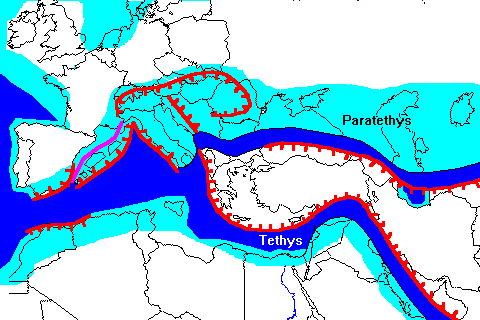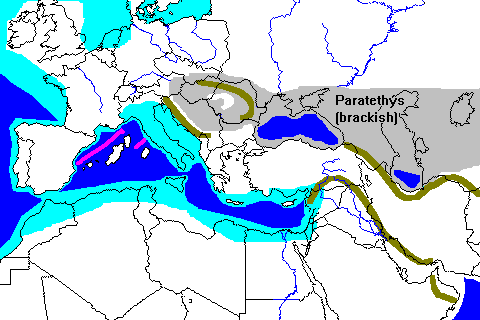Closure of the Tethys
Steven Dutch, Professor Emeritus, Natural and Applied Sciences, University of Wisconsin - Green Bay
The Drying of the Mediterranean
 |
The Mediterranean region 20 million years ago. Present coastlines are shown for reference only. Deep water is deep blue and shallow seas are light blue. The exact configuration of pieces making up Greece and Turkey are unknown.
This portion of the Tethys is about to close as Africa and Eurasia converge. However, there would have been no nead of a Suez Canal, and Columbus would not have needed to sail west to try to reach China. |
 |
By 10 million years ago, plate collisions have sealed off the eastern Mediterranean, trapping small remnants of ocean floor in the Black and Caspian Seas. Mountain barriers in the Balkans seal of a large inland sea, which becomes brackish as salt water is flushed out by river water. |
 |
By 6 million years ago, Spain and Africa collide, raising a mountain barrier and sealing off the western end of the Mediterranean. River inflow is not enough to maintain the level of the Mediterranean, which dries out.
However, rivers flowing to the Mediterranean can cut below Atlantic sea level. Eventually one does, and Atlantic sea water starts flowing in, cutting the Strait of Gibraltar and filling the Mediterranean. |
The Middle East

The Collision of India and Eurasia

 |
At first glance it looks as if India nestled into a pocket specially made for it. In fact, India has profoundly changed the outline of Asia. A simple experiment shows how. If a rigid block is pushed into a soft material like clay, it creates a network of criss-crossing faults ahead of it. Additional pushing causes wedges of clay to be pushed to the side, a process called tectonic extrusion. The bottom diagram looks remarkably like the actual geography of Asia.
To the west of India is the main mass of the Eurasian Plate, with a divergent plate margin and North America beyond that. Crust cannot be pushed easily to the west. But to the east are subduction zones where Asia is overriding the Pacific Plate. Crust can be easily pushed in this direction. |
 |
India has fractured the crust of east Asia into several subplates which have been pushed far to the east and southeast as the collision has progressed. The South China Sea opened as Borneo moved away from China. Also, Japan separated from the mainland, but it is not yet clear whether this was related to the collison of India and Eurasia |
 |
The animation shown at left starts at 60 million years ago. India pushes blocks of Asiatic crust eastward. Continental margin rocks smear along the margin of Southeast Asia, while the northern part of India thrusts beneath Tibet. |
Return to Plate Tectonics Page
Return to Physical Geology Class Notes Index
Access Crustal Movements Notes Index
Return to Professor Dutch's Home Page
Created 22 December 1998, Last Update 30 May 2003